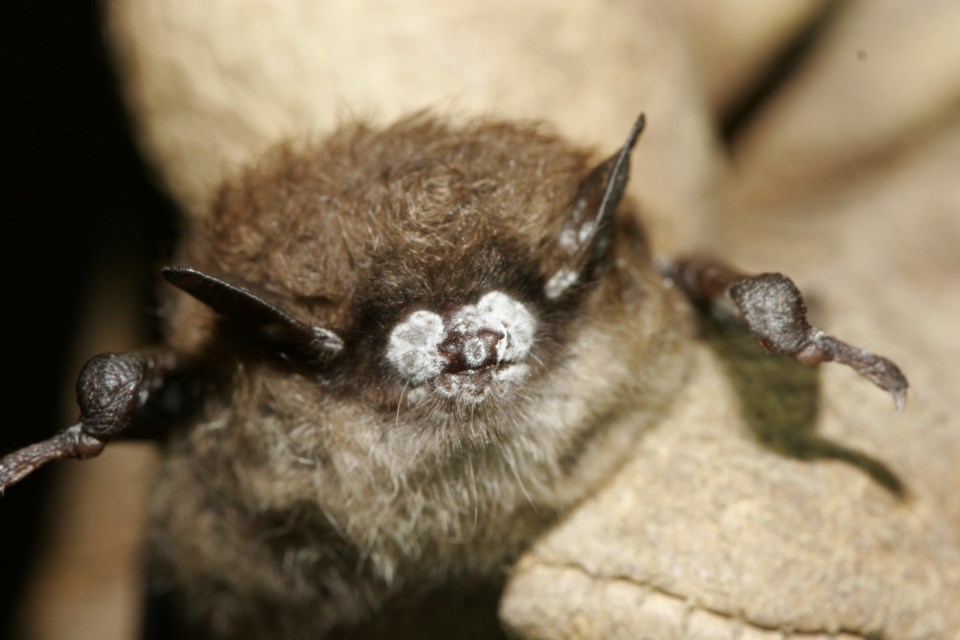Scott Hayes, Local Journalism Initiative Reporter | [email protected]
Alberta’s bats received bad news last week when it was announced that Pseudogymnoascus destructans – the fungus that causes white-nose syndrome (WNS) – had arrived in the province.
The news, however ominous, was not entirely unexpected.
Researchers and ecologists have been following its progression across the country for several years now. It was first discovered in Canada in various locations of Ontario and Quebec in 2010 before being detected in bats in Grasslands National Park in the south of Saskatchewan in 2021.
Once there, it seems like it might have gained momentum on its westward trajectory.
“It's not surprising to us that it showed up in Alberta, although the distance that it moved was a little unexpected,” said Cory Olson, program co-ordinator of the Alberta Community Bat Program with the Wildlife Conservation Society Canada (WCSC).
“It was over 500 kilometres. It's spreading quite quickly now, it would appear.”
That organization’s researchers collected bat droppings from underneath several hundred Alberta bridges that were known bat rest stops. Two samples from the southern stretch of the Red Deer River recently came back positive for the fungus while other samples indicate inconclusive results from along the Milk River in southern Alberta and both the Beaver River and the Battle River east of the Alberta-Saskatchewan border. Further studies will be conducted in the spring to confirm those reports.
Regardless, it “suggests the fungus is likely more widespread that current results indicate,” read a post on the Alberta Community Bat Program’s social media page. There are no indications that WNS has infected any members of the two bat species found in Jasper National Park at this time.
The disease has caused the deaths of several million bats across North America since 2006. P. destructans spreads from bat to bat as the creatures range over hundreds of kilometres, with infections blossoming during hibernation when the flying mammals are most vulnerable.
“During the summer, bats aren't really impacted, but when they go into hibernation, they drop their body temperature to just a little bit above freezing. When they're in that state, their immune system is not functioning normally. This fungus actually grows really well in cold conditions,” Olson said.
“[The bats] have to come out of hibernation. They have to burn energy stores to warm up their body. What happens is they deplete their fat stores, and they end up starving to death before the onset of spring when insects become available again for them to eat.”
The results are devastating as the fungus eats away at the bats’ skin, Olson explained. Population declines greater than 90 per cent have been documented for some species in eastern North America. Last year, biologists in Montana reported a 98 per cent decline in the number of bats occupying a cave.
There are few cave sites in western North America where bats can be monitored directly, and only one in Alberta. In Jasper National Park, parks staff have identified an overwintering site called a hibernaculum for the two bat species found locally. Recreational access to all caves is managed using a permit system in order to reduce the spread of white-nose syndrome. Both the little brown myotis and northern myotis bats are endangered species.
Brenda Shepherd, monitoring and species at risk biologist for Jasper National Park, asked the public at large to help out by being aware of and reporting both bats that are exhibiting strange behaviour or deceased bats. Of course, any bat activity during the winter would be unusual. April is typically when they start becoming active again.
“We would like to come and collect any dead bats because we will submit them for testing,” she said.
“It would be a really helpful thing that people can do to help us… to detect bats that may have white-nose syndrome. Really, we can't do much to stop white-nose syndrome but knowing where it is can help us.”
Those reports can be made by calling Jasper Dispatch at 780-852-6155.
Otherwise, Parks works to protect bats’ maternity roosts in order to provide them with the most supportive conditions toward having a healthy population.
“The healthier the population, the more [bats] that will be around after white-nose syndrome arrives,” she said.
Promoting bat-friendly management is one of the top things that the WCSC also does to help bats recover. The Alberta Bat Program has free resources and information on its website at .




